It all started one quiet morning on a rural, one-lane shortcut to Interstate 5 in Northern California. James Grage was tearing through the countryside in his Porsche 911, hurrying to a job interview, when he saw a pheasant standing alongside the country road. He honked to scare it away, but instead, the bird opened its 5-foot wings and flew right into—and through—his windshield.
James had a knee-jerk reaction to swerve. Before he knew it, he was face-to-face with a one-ton dually truck pulling a trailer loaded with agricultural harvesting blades—and moving just as fast as he was. James thought he was a goner. "The accident that was about to unfold was the kind you just don't live through," he says. He doesn't remember what happened next.
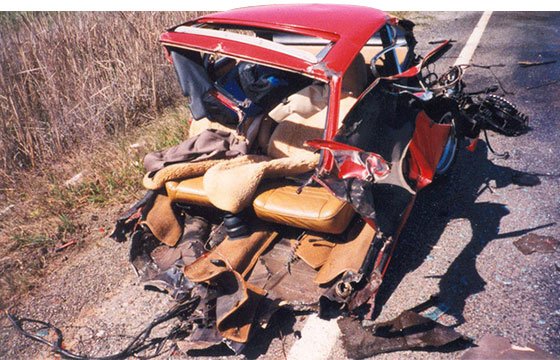
James was in his mid-20s, living in his hometown, and splitting his time as a personal trainer and corporate recruiter. He was trying to transition from the former to the latter, and he was on his way to an interview with a high-tech recruiting firm in San Jose when he saw the fateful fowl. He had been working paycheck-to-paycheck for months, had competed in a couple of low-level bodybuilding shows, and says he was ready "for a big change in my life." But what he was about to experience wasn't anything he could have predicted.
When he came to, James couldn't see or move, and the only sound he could hear was the crackle of burning grass sparked by the car's engine, which was separated from the chassis. Even though he had been thrown 95 feet, he didn't feel any pain. Instead, he recalls, "It was like when you fall asleep on the beach and wake up with the nice warm sun on your face, and you feel relaxed." Still, he tried yelling for help, even though what came out was a mere mumble. The woman driving a quarter mile behind him stopped to call 911, but was too shell-shocked by witnessing the crash to help.
Luckily, she wasn't the only one who saw the crash. That's where, as James puts it, his story gets "very cool."
Hitting Bottom
What's your name?
Where did you grow up?
Where did you go to school?
James heard these simple questions from a man who saw a plume of smoke in his rear-view mirror and took it upon himself to turn around and investigate. Finding James in a bloody heap, but alive, this stranger simply kept him talking, and a shared back-story began to emerge. As it turns out, James had gone to school with the man's daughter since the third grade, and the Good Samaritan also happened to be the father of James's roommate's girlfriend. "It was a weird twist of fate that brought me a lot of comfort," says James. "I was obviously in a state of panic, so that familiarity made me feel a little bit calmer."
At that moment, he needed all the help he could get. The impact of landing feet first had crushed both of James' femurs. He also broke his right hip, left fibula, left foot, left arm, and a host of smaller bones. When he was found, his feet were by his ears. The combination of a broken radius, navicular bone, and metacarpals in his left arm made doctors seriously contemplate amputating the arm.
Luckily, good fortune—and strong gym ties—came into play. A soft-spoken, white-haired doctor James had talked to while training at the gym happened to be the on-call orthopedic surgeon that day. "He knew me, and he knew fitness was important to me," James says, "so he went above and beyond and managed to try to piece me back together."
James got to keep his arm, but at a price. Today, in his words, "My whole body is just plates and rods."
A New Type of Challenge
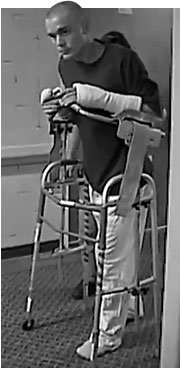
The accident came at a pivotal time. James was nearly broke, about to start a new job, and trying to move. The accident threw a wrench in those plans. "I wasn't going anywhere," he says. "I didn't have a car, and I didn't have a job. At the time it was hand to mouth. If I missed a paycheck, I missed putting food in my refrigerator. I could only imagine what every day in that hospital was costing." By the end of his five-week stay he racked up more than a million dollars in bills.
This immense adversity put James in "a bad space," but not for long. For years a friend's mother, who was a motivational speaker, had been feeding him a steady stream of books by the likes of Napoleon Hill, author of Think and Grow Rich. She also "dragged" him to a Tony Robbins seminar. Lying in his hospital bed, all the motivational mantras he regurgitated to his friends and training clients over the years began floating around in his head. Sayings like, "It's through adversity that the best opportunities in life come to us" and "For every bad thing that happens, there's a seed to an equal opportunity" punctuated the constant physical agony he was experiencing.
One morning, after being woken up early by throbbing pain, James watched the sun rise from his hospital room window and had an epiphany. "I realized that I was a huge hypocrite if I didn't take my own advice," he says. "'What better an opportunity than this?' I'd just had the slate wiped clean. Whatever path I was on was no longer possible."
It didn't take long before James' positive outlook began to power his physical drive. It was the only fuel he had; significant blood and bone marrow loss had left him weak and unable to replenish his blood cell stores. Sitting up for 60 seconds felt like running a marathon. So he began by setting small goals—very small.
After learning to sit upright and get his legs over the edge of the bed, James set his sights on walking. Despite having casts on both hands, he learned how to stand up, shuffle to the door and back, and eventually make it to the hallway with the assistance of a specialized walker. With each step, James fought against weakened bone strength, blood clots, and soft tissue damage. "Imagine being in socks, sliding one foot forward and then sliding the other foot up to it," he says. "It was an ordeal. There was a point when walking 100 feet took me a half-hour."
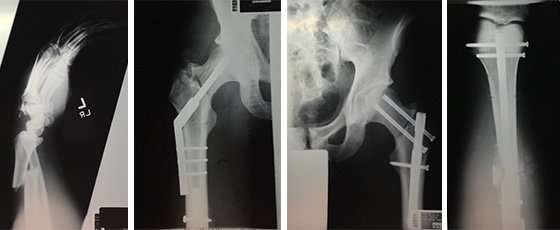
When the option of a rehabilitative hospital fell through because of limited insurance coverage, James was faced with the reality of having to recover in what was more or less a nursing home. "The only thing I had going for me was a good attitude, because everything else sort of sucked," he says. "Putting me in a convalescent hospital would have just killed my morale."
So, when the doctor came back with a challenge—walk around this entire floor, and I'll consider giving you home health care—James embraced it. Within six days, he'd completed the 60-yard lap.
Rebuilding Strength
When he got home, James faced another daunting challenge: Below the knee joint in both legs, he only had a four-degree range of motion. Blood had pooled in his lower body during the accident, and weeks of inactivity caused the area to calcify and muscle fibers hardened. This process by which bone forms within muscle tissue is known as heterotopic ossification. Weeks of excruciating physical therapy and more surgery only left him with minor gains. After consulting with his doctor, James decided to speed things up on his own on the stationary bike.
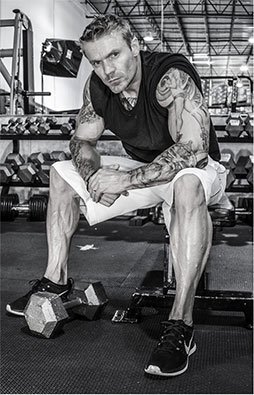
The doctor's prescription: Raise the seat as high as possible while still touching the pedals and go backward as far as you can in a revolution. Then rock forward and repeat. At first, James couldn't even do a full rotation. Still, he'd get a ride to his old gym, come in on his walker, make his way to the stationary bike, and sit there for an hour at a time. His former peers saw him and walked away with tears in their eyes. Two weeks later he not only completed a full revolution, he also moved on to the elliptical.
Once he was off the walker, James went back to a scaled-down version of his old bodybuilding routine. Motivation, muscle memory, and confidence gave him the push he needed to hobble from the elliptical to the leg press machine. Still, he had to make many modifications to his favorite old exercises. "I had no grip strength at all," he recalls. "The amount of strength it takes to staple a piece of paper—I didn't even have that." To improve, James started squeezing little foam balls and doing dexterity exercises. Knuckle push-ups replaced traditional ones, and using wraps to lock his hands to the bar became his bench press modification. Eventually, he scaled back to just wrapping his wrists.
Everyone he knew told him he was insane to be adding plates to his leg press when he still limped "like the Hunchback of Notre Dame," but James didn't listen. "I just made the decision that I was going to live my life instead of living it by what everyone told me I couldn't do," he says. "To me, it was all about quality, not quantity." While he had his limits—squats, for example, were out of the question—James nevertheless worked up to a five-plate leg press within a month of leaving the hospital. He performed triceps push-downs with a cast. As long as he could still use his fingers to grip the rope, there was no reason to stop.
While doctors and friends warned against it, James pushed on. At a time when he was and felt broken—his funds so drained he had to take a job an hour and a half away in Sacramento, his body so bony he was forced to sit on a pillow the entire drive—the gym provided stability. "It was the only thing keeping me sane and making me feel like I was making progress," he says.
Sick of the negativity, and of people telling him what he couldn't do, James set a definite goal for himself. He enrolled in the 12-week Body For Life challenge, and by the end, he'd built himself up to 180 pounds, carved out abs, and developed noticeable muscle tone.
Transforming also meant he was able to lose the cane that had become his psychological crutch. "With the cane, people knew there was something wrong with me," he says. "Ditching the cane meant I was just another skinny guy with a weird walk."

Nurturing Nutrition
Because he'd done a few bodybuilding shows before his accident, James had a solid base of nutrition and supplement knowledge. With his body struggling to meet the caloric demands of healing broken bones, mending soft tissue, and building up red blood cells, his experience with adding muscle mass was more valuable than ever.
Despite a near-total lack of appetite, James went back to what he knew best: a bodybuilder diet of six meals per day. "I just went back to the egg whites, chicken breasts, and broccoli," he recalls. "At first I couldn't eat much at each meal, but eventually it kickstarted my metabolism, and I developed a stronger appetite. This in turn led to more energy, which led to better workouts, which also fed back into my metabolism and appetite. Pretty soon the machine was running again."
Supplementation was also a top priority. James approached this from two angles: promoting bone repair, and encouraging the formation of new red blood cells. Along with regular doses of creatine and glutamine, James started taking a calcium-based "bone growth" supplement formula of phosphorous, potassium, magnesium, vitamin D and vitamin K. For blood health he took a vitamin B formula, but also made sure to get adequate amounts of iron, copper, and vitamin A, both from whole food and supplemental sources. For his joint injuries, James took a combination of glucosamine, chondroitin, MSM, bromelain, collagen, and manganese. To combat inflammation, he took a flaxseed-based omega-3 supplement.
James also worked to lower his cortisol levels, which rise when the body is stressed from illness or injury. Extended periods of elevated cortisol levels may break down muscle, contribute to atrophy, zap energy, and drop testosterone levels, all bad news for someone on the mend. James took phosphatidylserine, the then-newest supplement for reducing cortisol levels, following it with a strong dose of vitamin C.
"The nutrition aspect was hard," he admits. "I had to recreate that good habit and just stick to it. I laid out a game plan for myself, but it was hard work."
Bypassing Limitations
Six months after leaving the hospital, James says, nobody would have guessed that he was in a car accident. However, traveling long hours to a job he hated was still a major drain on his self-confidence. Wanting to give James a boost, a friend invited him to Expo West in Anaheim, a trade show for natural and organic products. With a suit on and resume in hand, he walked in, forced a few informal interviews, and walked out with his first job in the industry: sales rep for a sports nutrition company.
Getting back into the fitness business didn't come without its risks, though. "I still had a lot of limitations," says James. "One day, a guy I worked with was like 'Come on, let's do this.' So we went to the gym and did this insane leg workout—deadlifts, squats, everything. I couldn't walk for like a week after that, but I did it."
James Grage's Recovery Tips
- Be Compelled To Change: Your desire for change has to be enough to propel you forward. Imagine a bobsled team: No matter how well it runs the track, the time won't be any good if the team doesn't get a strong push at the start.
- Set A Specific, Measurable Goal: It all comes down to the details. Don't overwhelm yourself with a goal that's bound to take years. Instead, break that goal down into manageable, bite-sized steps with specific timelines. And write them down. Putting pen to paper might seem insignificant, but it makes things seem definite and real.
- Visualize Goals: Don't just picture your goal. Imagine what it will look and feel like to accomplish it. How much more confident would you be? How proud would you feel? If negative self-talk seeps in, use it to your benefit.
- Carve Out Personal Motivators: Find what fuels you. I hate the thought of someone feeling sorry for me, so while I was recovering, I would picture people saying "Oh, look at that poor guy. He's in really bad shape. I wonder what happened to him." That was a real motivator.
- Stay Committed: Never worry about the "how" before getting started. Working yourself up about potential obstacles will only lead you to discouragement and increase the chances that you'll talk yourself out of it before you even start.
- Do More, Talk Less: Spending all your time talking up your plans to exercise can drain your "pool of enthusiasm" to the point where you don't actively do much to accomplish your goal. I'm a little superstitious with my goals: I go about them in a quiet way and direct all my energy toward doing.
- Work Hard, Be Consistent, And Don't Make Excuses: There's no substitute for hard work. You can have the best game plan in the world, but if you only put in half-effort, that's what you'll get for results.
- Celebrate Accomplishments: Once you reach a goal, set a new one. But before you do, take a moment to acknowledge and celebrate your accomplishments.
Such speed bumps notwithstanding, strength training and regular stretching helped James regain his strength. After a year, he'd shaken the last remnants of his limp. In 2004, he conquered a feat he'd previously deemed impossible: returning to the stage. "One day I woke up and was like 'Why am I putting that limitation on myself? Who says I can't?'" he says. He stepped it up, trained harder, and won both his class and the overall prize at a show in Florida. He went on to win the NPC Southern States as well, but it was about more than just a trophy. "It was about overcoming something that I told myself I couldn't do," he says. "It was more about the limitations than it was competing, so I felt satisfied."
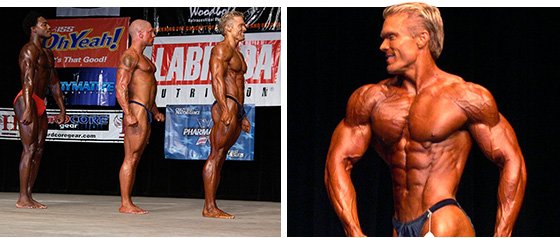
Around that time, James made the switch from supplement rep to head of business development for Weider Publications, where he worked on Muscle & Fitness, Flex, and Muscle & Fitness Hers. But the healing power of nutrition continued to fascinate him. After seeing his physique, a nutrition store owner in Florida recommended that James talk with a supplement entrepreneur he knew. In 2009, BPI Sports was founded. The company has since skyrocketed to international prominence. BPI recently signed four-time Mr. Olympia Jay Cutler.
Living For Now
Today, 14 years after the accident, James says he has largely kept this incredible story to himself until now. It is visible on his body, though, in the form of heinous scars that travel along his sides, from hip to knees, and a right hand he describes as "sliced and diced." He'll always have some limitations, but they're not his focus. "I still have residual pain," says James. "A negative way of saying it would be 'chronic' pain, but I don't give it that power over me."
James Doesn't Tell His Story Often

"The more you talk, the more you give naysayers the opportunity to knock you down. When I told doctors I wanted to start lifting again, all I heard was discouragement. I hear others say you need a support network to help you stay committed and on track. I believe motivation comes from within—nobody can infuse you with it."
This isn't to say that his past doesn't weigh down on him on a regular basis. "The first 4-5 steps out of bed every morning are awful," he admits. "My hips hurt, my wrists hurt. It's kind of like a weird limp—I'm almost the 'Evolution of Man' chart. I start off real low to the ground, and with each subsequent step I get a little more upright as I walk down the hallway."
He remains disciplined about stretching, but James no longer lifts as heavy as he used to. His new, modified routine leaves him feeling healthy, and he's confident he can sustain it long-term. "Next year I turn 40, and I've got two kids. One is 6, and one is 6 months old," he says. "When they're older I want to be able to run around and play with them. I don't want to be a crippled man." Still, he powers through 45 minutes of morning cardio daily, lifts weights at midday, and occasionally bikes to the office.
At roughly 6 percent body fat, James says he could probably do a physique show, but it's no longer his thing. Staying active and in shape is. He still takes BPI's Clinical Power Series line and follows a clean nutrition regimen.
For James, it has all come full circle, and nothing was for naught. "People always ask me, 'Would you ever change the worst things that happened to you in your life?'" he says. "I say 'How could you? If you're happy with who you are and where you are, how can you possibly have any regrets? It's all part of your path.'"


Training Regimen that Helped James
"The injuries to my legs and hips were so extensive that I had to split my leg training—quads, hams, and calves—into different days, allowing for as much rest as possible between each. I also had to substitute and modify some exercises. I didn't have the strength or balance to do regular free-weight squats. In addition to knee and ankle injuries, a permanent tear in the vastus medialis tendon in my left quadriceps was further compounded by a plate in my right hip that was rubbing against my iliotibial band (IT band), causing severe pain on the whole right side of my leg.
To work around this, I had to start by working the larger muscles—quads and hams—with machines only. I'd then work in stabilizer exercises to work smaller muscles and overall balance. Stretching and massage were also keys to my recovery. I had a lot of scar tissue built up, so every day I'd spend 30 minutes stretching all the muscle in my lower body and using a dense foam roller to massage the muscles and encourage blood flow."